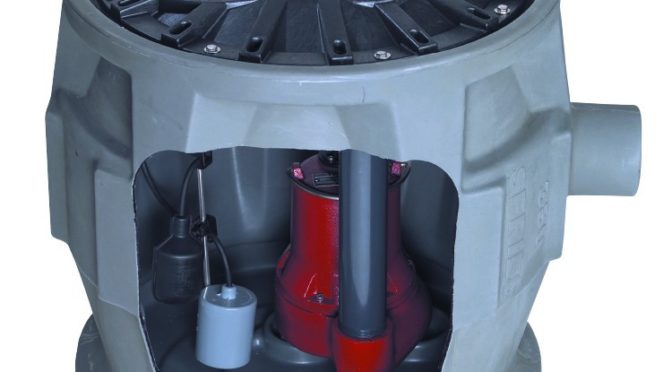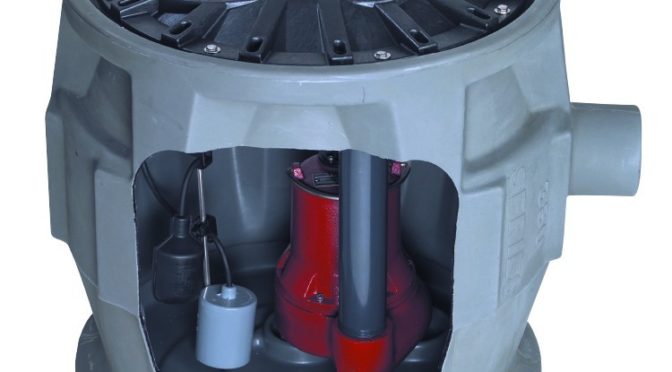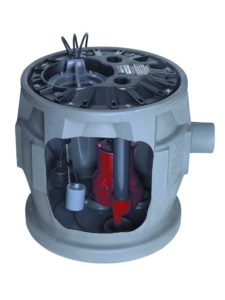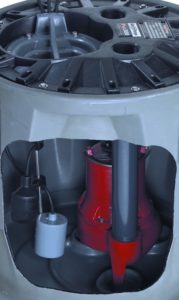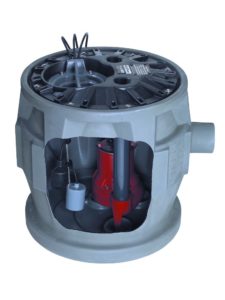 If you have a septic tank, a toilet in the basement, or any other kind of below-grade sewage system, you’re not going to be able to take advantage of a gravity drain line, and you’re going to need a sewage pump. There are a lot of options out there to consider for homeowners, landlords, and small business owners, and each promises the sea and sky. But we’ve learned that going cheap often means frequent, fast, and not at all cheap failures to clean up and pay for (often during emergency billing hours). We prefer jobs done quickly and for the long term, which is why we frequently only recommend either sewage ejector pumps installed via pre-assembled systems or direct upgrades to sewage grinder pumps. In fact, many licensed plumbers will only install pre-assembled systems simply because the reliability of individual pumps in a patchwork of pipes, floats, and basins simply can’t compare. And a good grinder will beat even the best pre-assembled ejector system.
If you have a septic tank, a toilet in the basement, or any other kind of below-grade sewage system, you’re not going to be able to take advantage of a gravity drain line, and you’re going to need a sewage pump. There are a lot of options out there to consider for homeowners, landlords, and small business owners, and each promises the sea and sky. But we’ve learned that going cheap often means frequent, fast, and not at all cheap failures to clean up and pay for (often during emergency billing hours). We prefer jobs done quickly and for the long term, which is why we frequently only recommend either sewage ejector pumps installed via pre-assembled systems or direct upgrades to sewage grinder pumps. In fact, many licensed plumbers will only install pre-assembled systems simply because the reliability of individual pumps in a patchwork of pipes, floats, and basins simply can’t compare. And a good grinder will beat even the best pre-assembled ejector system.
That said, you might not need a sewage grinder pump like the Liberty Pumps PRG101A for your home, rental, or business. If you’ve got family, tenants, customers, or employees who only flush toilet paper and human waste, you’ll be just fine with an ejector pump. But to get as many years as possible out of a sewage ejector pump, you’ll want something pre-assembled like the Liberty Pumps P382LE51 or its slightly less powerful sibling, the Liberty Pumps P382LE41 Simplex Sewage System. It’s just as easy to set up, just as reliable, and just a little cheaper. Our full review is below, and you can buy it here.
Key Features of the Liberty Pumps P382LE41 Simplex Sewage System (60 Second Summary)
 The Liberty Pumps P382LE41 is a pre-assembled residential sewage ejector package with a shallow system design. It can also be used in light business settings. Powered by the LE41A sewage pump, it delivers 4/10 horsepower and has an adjusted maximum flow rate of 7,640 gallons per hour (124 gallons per minute) with a max head of 19 feet. It includes the standard Liberty Pumps3 year warranty and is 24 inches tall with a base diameter of 24-3/8 inches and a widest diameter of 27-5/8 inches. The system arrives fully assembled weighing 60 pounds.
The Liberty Pumps P382LE41 is a pre-assembled residential sewage ejector package with a shallow system design. It can also be used in light business settings. Powered by the LE41A sewage pump, it delivers 4/10 horsepower and has an adjusted maximum flow rate of 7,640 gallons per hour (124 gallons per minute) with a max head of 19 feet. It includes the standard Liberty Pumps3 year warranty and is 24 inches tall with a base diameter of 24-3/8 inches and a widest diameter of 27-5/8 inches. The system arrives fully assembled weighing 60 pounds.
The P382LE41, like other members of the Pro380 series, is optimized for installation in difficult soil environments due to requiring shallower burial than Pro370 series systems. It can pass solids up to 2 inches in diameter and uses 115 volts single phase AC at 12 amps at full load and 22.5 locked rotor amps. Thermal overload protection shuts the motor down at 221F and the motor will pump liquids at up to 140F. The pump uses an automatic mechanical wide angle float and a 2 inch FNPT discharge.
The P382LE41 tops out at 7,680 GPH at zero feet (slightly less than the standalone LE41A), which drops to 5,760 GPH at 10 feet and shuts off at the max head of 19 feet. The system includes the QuickTree float design, which permits access, removal, and replacement of the float switch from a vertical seal in the basin without impacting the pump or plumbing. The pump is fixed within a 41 gallon polyethylene basin with a capacity 40% larger than that in 18 inch x 30 inch basins, which reduces on/off cycles in both the pump and switch, increasing the lifespan of both. The P382LE41 ships fully assembled and includes a plastic transparent cover to protect the top from rough-in and masonry work.
How Does the Liberty Pumps P382LE41 Compare to the Liberty Pumps P372LE51 and PRG101A?
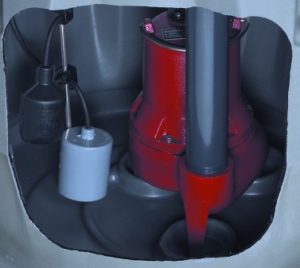 The main differences between the P382LE41 and 51 are in power, pumping speeds, max head, and price. The PE382LE51 is stronger (.5 hp vs .4 hp), faster (8,400 GPH vs 7,680 GPH), pumps to a higher head (24 feet vs 19 feet), and costs somewhat more. In practical use, most of these differences will be negligible except for the max head, which will only be noticeable if you’re pushing either pump close to its limits. Reliability is the same between both pumps; you can expect up to 20 years of functionality.
The main differences between the P382LE41 and 51 are in power, pumping speeds, max head, and price. The PE382LE51 is stronger (.5 hp vs .4 hp), faster (8,400 GPH vs 7,680 GPH), pumps to a higher head (24 feet vs 19 feet), and costs somewhat more. In practical use, most of these differences will be negligible except for the max head, which will only be noticeable if you’re pushing either pump close to its limits. Reliability is the same between both pumps; you can expect up to 20 years of functionality.
The core difference between the P382LE41 and the PRG101A is that the latter is a grinder pump rather than just an ejector pump, which means it will be able to handle a wide range of difficult solids that would simply jam or damage the LE41A inside the P382LE41. If you can’t afford downtime or pump damage due to the potential of people flushing towels, rags, feminine hygiene products, and other things that shouldn’t be flushed but frequently are, save your money and move directly to the PRG101A. It’ll additionally provide a much stronger motor (1 hp vs .4 hp) and more than twice the max head at 50 feet compared to 19 feet.
Our Short and Long Term Experiences Installing and Using the Liberty Pumps P382LE41 Sewage Package
Installing the P382LE41 is essentially identical to the process for the P372LE51, P382LE51, and P372LE41; just follow the instructions, take your time (about 7 hours), and make sure you have extra tubing, check valves, ball valves, and couplings handy. As with most sewage ejector pump installations, you simply run a main line in (e.g., a 2 inch or 3 inch line) and run a 2 inch discharge and 2 inch vent out. The float arrives pre-set in an optimal position in the basin. The main complaint we frequently come across is that the pump is often out of place in the enclosure upon arrival. In some cases, it was mildly connected, while in others it was placing pressure on the riser pipe or on the basin lead seal. Don’t be afraid to call customer service if anything arrives broken on arrival.
Noise-wise, the system isn’t silent, but it’s more than quiet enough to forget it’s running while you’re in the basement once the euphoria of a successful installation wears off. In terms of reliability, it’s about as reliable as the P382LE51, which is as reliable as the P372LE51, which you can expect up to 20 years of problem-free functionality from due to the life-extending properties of the basin and integration of the parts in the enclosure. The part most likely to fail over time is the switch, and as noted earlier, that can be pulled without doing anything significant to the pump or anything whatsoever to the plumbing.
Troubleshooting and Installation Tips to Get Your Liberty Pumps P382LE41 Working Sooner
If connecting the P382LE41 to existing plumbing, make sure there aren’t any blockages in your existing pipes, or you might have a messy surprise the first time you run it. Similarly, don’t forget that you’re going to need both a ball valve and a check valve; the check valve will go on your discharge to prevent back flow and the ball valve and a few unions will help you remove the lid in case you need to inspect or service the pump.
Liberty Pumps P382LE41 Simplex Sewage System Pros, Cons, and Value Comparison
In conclusion, if you don’t need quite as much power as what you’d get from the P382LE51 but love the convenience, quick installation, and reliability of the pre-assembled approach, the P382LE41 is an excellent choice for a bit less money. It’s durable, relatively simple to install, and provides no-nonsense functionality for years while not needing constant supervision. Our main recommendation would be to consider the PRG101A if you absolutely can’t afford any downtime or if you will install the sewage pump in an environment where clothing, feminine hygiene products, towels, rags, wipes, or other difficult solids are likely to be flushed down the toilet. If this doesn’t describe your operating environment and you don’t need quite as much head or speed as that offered by the P382LE51, the P382LE41 will work just fine.
You can buy the Liberty Pumps P382LE41 here on Amazon. You can buy the Liberty Pumps P382LE51 here. You can buy the Liberty Pumps PRG101A here. You can buy a good wet / dry vacuum here. You can buy a silent 2 inch check valve here. You can buy a 2 inch brass ball valve here.
 If you find our work at PumpThatSump helpful, you can put our relentless reviewing of every pump and fixture on the market to the test by shopping via our links above for whatever you need to make your house a home. Despite being self-employed, we promise not to spend it all on health insurance.
If you find our work at PumpThatSump helpful, you can put our relentless reviewing of every pump and fixture on the market to the test by shopping via our links above for whatever you need to make your house a home. Despite being self-employed, we promise not to spend it all on health insurance.
